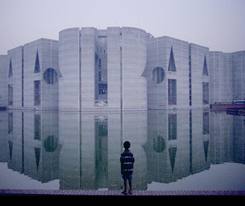Dancing About Architecture

Louis Kahn’s National Assembly Building in Dhaka, Bangladesh from “My Architect”
The humorist Martin Mull is said to have said that talking about music is like dancing about architecture, an insufficient response to a profound stimulus. Still, I have a powerful response to films where the camera dances about architecture, revealing aspects of environments, both built and natural, that don’t communicate themselves so fully to the naked eye. There are occasions when structures are more eloquent if seen through the sympathetic eyes of a filmmaker or photographer. Structures, like actors, have best angles and respond to careful lighting.
Some cases in point.
My Architect, in which Nathaniel Kahn visits the buildings of his father, architect Louis Kahn, in order to better understand this distant figure in his life. I went to college at UC San Diego, and spent a lot of time at Kahn’s Salk Institute, but I never experienced it as an earthwork charting the the hours between sunrise and sunset until I watched the younger Kahn’s personal essay of a film that suggests the scarring of the building’s cast-concrete face bears a relation to the scarring the architect sustained in a fire during childhood.
The Namesake, Mira Nair’s exquisite adaptation of the Jhumpa Lahiri novel, sets an important sequence at the Taj Mahal,to show how the structure that sparks the film’s central character, Gogol (Kal Penn), to a career as an architect. In a whirl that takes in Taj’s whole as well as its decorative elements, Nair shows how the relationship between a person and a building can be love at first sight. It begins with a first glimpse and ends with a caress of an architectural detail.
The Motorcycle Diaries, Walter Salles’ chronicle of the young Che Guevera’s road trip through South America, stops at Macchu Picchu where Che (Gael Garcia Bernal) looks down from the Incan capital to Cuzco and imagines a unified South America.
The Passenger, Michelangelo Antonioni’s film in which a reporter (Jack Nicholson) falls in love with a mystery woman (Maria Schneider) amid the tile outcroppings on the roof of Antonio Gaudi’s La Pedrera, trying to find his footing in a structure without right angles or parallel lines.
There are so many other examples I could name, like Frida Kahlo’s and Leon Trotsky’s excursion to the ruims of Teotihuacan in Julie Taymor’s Frida, or the record of Julius Shulman’s architectural photography in Visual Acoustics, or the details of the Chrysler Building in Brian De Palma’s Bonfire of the Vanities.
What I want to know, are there movies that have made you see or understand architecture in a new light? Why do you think?



Are buildings like actors, do they have best angles and respond to lighting? http://t.co/v95To7Rc
Fiction films by Wong Kar-Wai dance about architecture best. His celebration of Iguacu Falls at the end of HAPPY TOGETHER and the way he films Angkor Wat at the end of IN THE MOOD FOR LOVE are stunning.
I also find the documentary, IN THE PIT an amazing film. Depicting the contruction workers who build a superhighway in the center of Mexico City, the film ends with a breathtaking 8 minute tracking shot that has to be seen to be beleived.
Jacques Tati’s “Playtime”
Several movies come to mind. Under the Tuscan Sun and Eat, Love,Pray, and Kinky Boots all three show us all the great architecture of Italy .Kinky Boots gives us the streets of English contryside. I will never understand how they managed to build with such crude tools and have them last as long as they have
My Architect definitely. I can still envision the shot of the Bangladesh Parliament building in Dhaka. Even good TV keeps me thinking about architecture: Consider the home Mad Men’s Don Draper shared with Betty in the burbs compared to the horizontal, open-spaced home he shares with Megan.
You’re absolutely right about archtecture as actor. My three favorite building-thespians are Villa Malaparte in Le Mepris, 30th Street Station in a number of roles (it’s really wonderful in Blow-Out) and, if you’ll allow this, the Vienna sewers in The Third Man.
Hitchcock used architecture and spaces to great effect: the inn and the music hall in The 39 Steps, the aircraft hanger and the Statue of Liberty in Saboteur, Grand Central, the cornfield and Mt. Rushmore in North By Northwest, and the interior courtyard with views into NY apartments in Rear Window. The mundane places and the monuments are equally beautiful and dramatic.
Wow that was odd. I just wrote an extremely long comment but after I clicked submit my comment didn’t show up. Grrrr… well I’m not writing all that over again. Anyhow, just wanted to say superb blog!